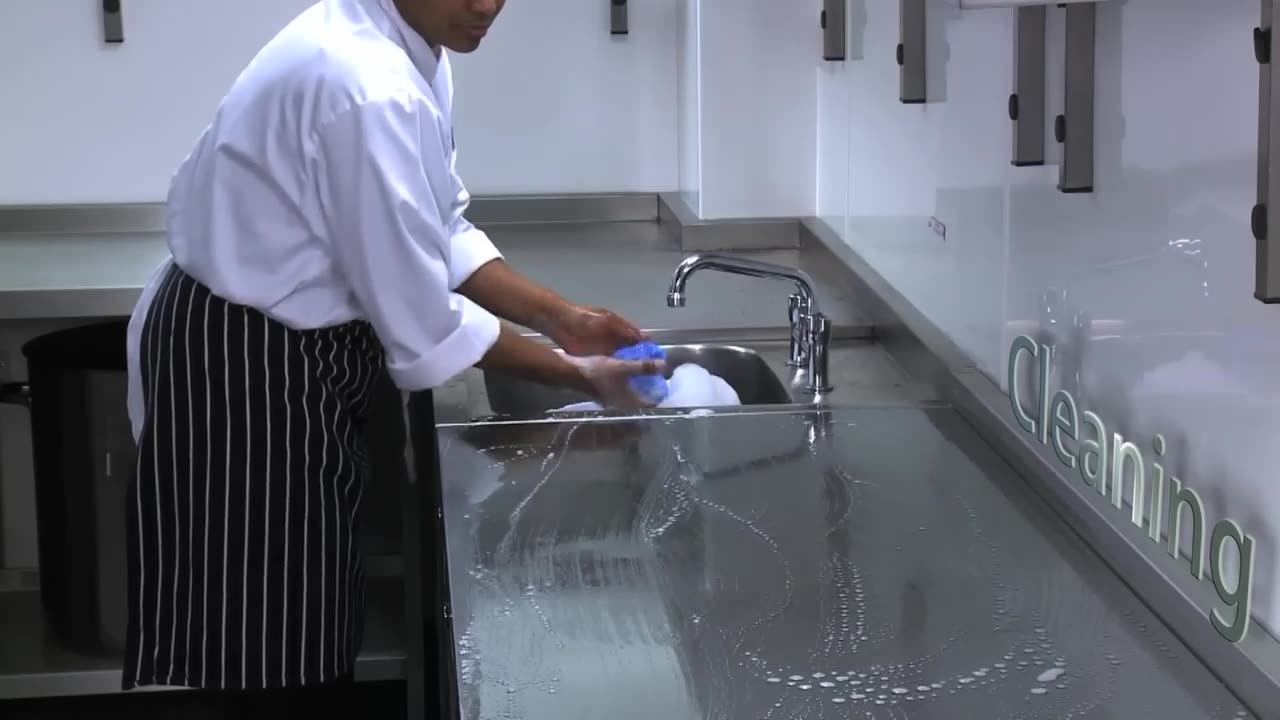Premium Only Content

Food safety coaching (Part 6)_ Cleaning effectively
### **Food Safety Coaching (Part 6) – Cleaning Effectively**
Effective cleaning is one of the most crucial practices for maintaining food safety in any food establishment. Proper cleaning prevents the spread of harmful bacteria, viruses, and allergens, ensuring that food is safe to prepare and consume. Cleaning surfaces, utensils, equipment, and facilities correctly helps to minimize cross-contamination and maintain a hygienic environment.
---
### **Why Cleaning Effectively Matters**
1. **Prevents Cross-Contamination:**
- Cleaning removes food residues, bacteria, and other contaminants that can spread between raw and cooked foods, surfaces, and utensils.
2. **Maintains Food Safety Standards:**
- Regular cleaning is vital to meet health and safety regulations and avoid foodborne illness outbreaks.
3. **Ensures Food Quality:**
- Clean environments contribute to better food preservation, taste, and appearance.
---
### **Key Steps for Effective Cleaning**
#### **1. Clean in the Right Order**
- **First, clean clean areas:** Start with the cleanest areas, like countertops and utensils that handle ready-to-eat food.
- **Next, clean dirty areas:** Tackle areas with raw foods, such as meat preparation areas, last to avoid contaminating the already clean areas.
- **Finally, wash floors and trash cans:** These should be cleaned last as they are typically the dirtiest.
#### **2. Use the Correct Cleaning Materials**
- **Soapy Water:** For removing dirt, grease, and food residues.
- **Sanitizers:** After cleaning, use sanitizers to kill bacteria and viruses. Choose a sanitizer that is suitable for food contact surfaces.
- **Rinse Thoroughly:** After sanitizing, rinse surfaces with clean water if needed to remove any residue from cleaning agents or sanitizers.
#### **3. Cleaning Equipment and Tools**
- **Use the right cleaning tools:** Choose brushes, cloths, and sponges that are appropriate for the task.
- **Regularly sanitize cleaning tools:** Keep cloths, sponges, mops, and brushes clean. Dirty tools can spread contaminants instead of removing them.
- **Change water frequently:** Dirty water can reintroduce bacteria. Always use fresh water when cleaning and sanitizing.
#### **4. Clean Food Contact Surfaces Regularly**
- **High-touch areas:** Ensure food contact surfaces, such as countertops, cutting boards, knives, and utensils, are cleaned after each use.
- **After handling raw meat:** Clean surfaces immediately after preparing raw meat, poultry, seafood, or eggs to avoid cross-contamination.
- **After preparing ready-to-eat foods:** Even though these foods don’t require cooking, clean surfaces after working with them to remove allergens, dirt, and microbes.
#### **5. Maintain Proper Hygiene in the Kitchen**
- **Employee hygiene:** Ensure employees wash hands regularly, particularly after handling raw foods, using the restroom, or touching their faces.
- **Clean uniforms:** Staff should wear clean, appropriate uniforms to avoid transferring dirt and bacteria to food preparation areas.
#### **6. Clean and Maintain Equipment**
- **Deep cleaning for large equipment:** Ovens, grills, fryers, and refrigerators require regular cleaning and deep cleaning (e.g., once a week or more) to remove grease and food particles.
- **Dishwashing:** Ensure that dishwashers are properly cleaned and maintained for optimal performance. If washing dishes by hand, use hot water (at least 60°C/140°F) and follow the three-sink method (wash, rinse, sanitize).
---
### **Common Mistakes to Avoid**
1. **Not Cleaning After Each Task:**
- Don’t wait until the end of the day to clean; clean between tasks to prevent contamination.
2. **Using Dirty Cleaning Tools:**
- Ensure that cleaning cloths and sponges are kept clean and replaced regularly to avoid spreading bacteria.
3. **Skipping Sanitization:**
- Cleaning removes dirt but does not kill bacteria. Always sanitize after cleaning to ensure surfaces are safe.
4. **Overusing Cleaning Products:**
- Follow the manufacturer’s instructions for cleaning agents, and avoid overuse. Too much cleaner can leave residues that may affect food safety.
---
### **Key Tips for Effective Cleaning**
- **Create a cleaning schedule:** Keep a routine cleaning log to ensure all areas are cleaned regularly and systematically.
- **Train staff:** Properly train employees on cleaning procedures, the importance of hygiene, and the proper use of cleaning agents.
- **Monitor cleaning practices:** Inspect areas regularly to ensure cleaning tasks are being completed correctly.
---
### **Key Reminder**
Effective cleaning is a fundamental practice in preventing contamination, maintaining a safe environment, and ensuring the highest standards of food safety. Regular cleaning routines, correct use of cleaning tools, and proper sanitation should be integral parts of your food safety plan.
Would you like specific advice on cleaning for a particular area or type of equipment in your establishment?
-
 36:28
36:28
TheTapeLibrary
16 hours ago $10.33 earnedThe Disturbing True Horror of the Hexham Heads
63K6 -
 6:08:00
6:08:00
JdaDelete
1 day ago $2.44 earnedHalo MCC with the Rumble Spartans 💥
42.1K7 -
 3:52:22
3:52:22
Edge of Wonder
10 hours agoChristmas Mandela Effects, UFO Drone Updates & Holiday Government Shake-Ups
37.5K12 -
 1:37:36
1:37:36
Mally_Mouse
9 hours agoLet's Play!! -- Friends Friday!
42.2K1 -
 57:45
57:45
LFA TV
1 day agoObama’s Fake World Comes Crashing Down | Trumpet Daily 12.20.24 7PM EST
38K16 -
 1:27:17
1:27:17
2 MIKES LIVE
8 hours ago2 MIKES LIVE #158 Government Shutdown Looms and Games!
33K10 -
 1:07:34
1:07:34
The Big Mig™
12 hours agoVeteran, Patriot, Leader, Author Allen West joins The Big Mig Show
31.4K8 -
 1:06:47
1:06:47
The Amber May Show
1 day ago $1.26 earnedBloated CR Failed | What Did The View Say Now? | Who Kept Their Job At ABC| Isaac Hayes
19K2 -
 59:29
59:29
State of the Second Podcast
4 days agoAre We Losing the Fight for Gun Rights? (ft. XTech)
33.3K3 -
 1:00:10
1:00:10
The Nima Yamini Show
9 hours agoTragedy in Germany 🇩🇪 Suspected Terror Attack at Christmas Market – LIVE Updates from Germany
34.8K47